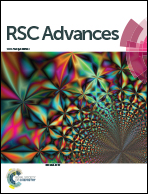Synthesis, structures, and properties of seven transition metal coordination polymers based on a long semirigid dicarboxylic acid ligand†
Abstract
Seven transition metal coordination polymers associated with a long dicarboxylic acid ligand have been synthesized under hydrothermal conditions, namely, [ZnL(H2O)]n (1), [CdL(H2O)2]n (2), [CoL(H2O)2]n (3), [MnL(phen)(H2O)]n (4), {[NiL(phen)]·H2O}n (5), [CuL(bpp)0.5]n (6a, 6b), (H2L = 1,4-bis(4-oxy-1-benzene carboxylic acid)benzene, phen = 1,10-phenanthroline, bpp = 1,2-di(4-pyridyl)ethane). Compounds 1–6 have been characterized by elemental analysis, IR spectra, TGA, powder X-ray diffraction (PXRD) and single crystal X-ray crystallography. Compound 1 displays an undulating 2D layered structure. Isostructural 2 and 3 exhibit the three-dimensional framework structures containing the 1D channel. Compounds 4 and 5 have similar 1D wavelike chain structures. Compounds 6a and 6b are four-fold interpenetrated three-dimensional supramolecular isomers, and it is a remarkable fact that the semirigidity of the H2L ligand has brought about the diverse structures of 6a and 6b. The solid state luminescence of 1 and 2 and magnetic properties of 3 were investigated.


 Please wait while we load your content...
Please wait while we load your content...